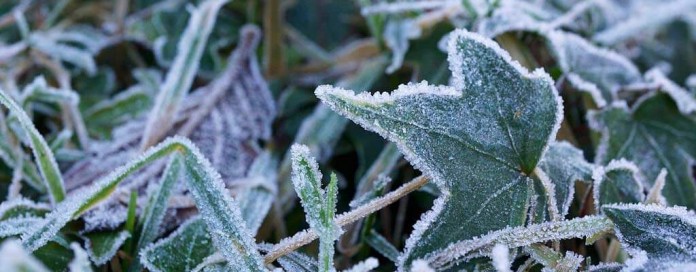
Just like it’s important to know the last frost date in the spring, it’s crucial for home gardeners to know when the first expected frost date will occur in the fall.
Frost and freezing temperatures can kill tender crops such as tomatoes, peppers, snap beans and squash at the end of the gardening season. Prepare now so that your plants are protected when the season’s first frost occurs.
What’s a frost?
National Oceanic and Atmospheric Administration’s National Weather Service defines ‘frost’ as “the formation of ice crystals on the ground or other surfaces in the form of scales, needles, feathers, or fans.” Frost occurs when temperatures fall below 32 degrees Fahrenheit. Typically, a frost can be expected when temperatures are in the mid-30s.
A frost is referred to as a ‘killing frost’ if it ends a growing season or delays one from beginning.
How can I protect my plants from frost?
Marin Master Gardeners from the University of California, Division of Agriculture and Natural Resources says that ice crystals form in plant cells when it frosts, preventing water from reaching plant tissues. You’ll know if your plants have been damaged by frost by their appearance; if leaves have turned dark brown or black, have become shriveled or if they look water-soaked, chances are they’re injured by frost.
Penn State Extension explains that covering plants before the sun goes down will help them to retain heat in the event of frost. Pay attention to local weather forecasts so you know when temperatures in the mid-30s are expected.
According to University of Nebraska-Lincoln Extension in Lancaster County, crops can be covered with various materials, depending on how they grow. Covering plants will retain heat from the soil around the crops. If plastic is used to cover plants, remove it the morning since plastic will hold heat in and potentially “cook” plants.
Since cucumbers are low-growing, cover them with newspapers, straw or even old bed sheets. Caged tomatoes, peppers and eggplants can be covered with paper grocery bags or trash bags.
It’s best to harvest summer squash before frost since plants will wilt after frost.
Plants like carrots, peas, chives, spinach and lettuce and handle some frost. Cole crops, like broccoli, cabbage, Chinese cabbage, cauliflower and Brussels sprouts don’t necessarily need covered when frost is in the forecast. In the event of a freeze, though, these plants may not keep for as long.
Another way to protect plants from frost damage is to water them. Cornell University explains that this will help to maintain their internal temperatures above freezing.
What do I do with crops that have been damaged by frost?
University of Nebraska-Lincoln Extension in Lancaster County says tomatoes damaged by frost must be canned or frozen within two days. Beans should be picked, used and processed as soon as possible after frost.
Peppers won’t be suitable for eating or canning after frost since they turn black and mushy.
What’s a freeze?
A freeze occurs when surface air temperatures fall below 32 degrees Fahrenheit over a widespread area for a significant length of time. When these conditions are forecasted, freeze warnings are issued by NOAA.
An advective freeze is windborne; freezing temperatures are brought on by a cold air mass. Winds of 5 miles per hour or higher and clouds may occur.
A “killing freeze” will kill all but the hardiest herbaceous plants, according to Penn State University Extension.
How can I protect my plants from freeze?
When a windborne freeze occurs, it isn’t likely that you can protect plants. Ice crystals form in plant cells during freezing temperatures, causing cells to rupture, which kills the plants.
Bring plants (like flowers or potted plants) indoors if at all possible when a freeze is forecasted
Once winter sets in, Ohio State University Extensionexplains that 2 to 2.5 inches of mulch should be applied around perennials, rock garden plants, alpine, strawberry or plants that have shallow roots after the soil freezes. This will keep the soil from freezing, thus reducing plant root injury.
The bodies of evergreen trees can be wrapped with burlap or canvas to protect against sun, wind and drifted de-icing salt.
What do I do with crops that have been damaged by freeze?
Wait before pruning plants that may have been damaged by a freeze. Clemson University recommends assessing the damage before pruning or removing plants.
When should I expect the season’s first frost and freeze?
The National Weather Service’s Forecast Office offers historical data for your region. For instance, if you live around the Cleveland area (Toledo, Mansfield, Akron, Youngstown or Erie, Pennsylvania), NWS provides data based on climate normals for the average first freeze, earliest and latest freeze, average first frost and earliest and latest frost.
Average Ohio fall first freeze dates can be viewed here and spring thaw dates can be viewed here.
More about gardening in the fall:
- 5 simple season extenders for the fall garden Sept. 4, 2015
- Plant bulbs this fall Aug. 21, 2015
- How to clean up your garden for fall Aug. 21, 2015
- Fall gardening guide Aug. 7, 2015
- Three ways to extend your gardening season Aug. 19, 2014










